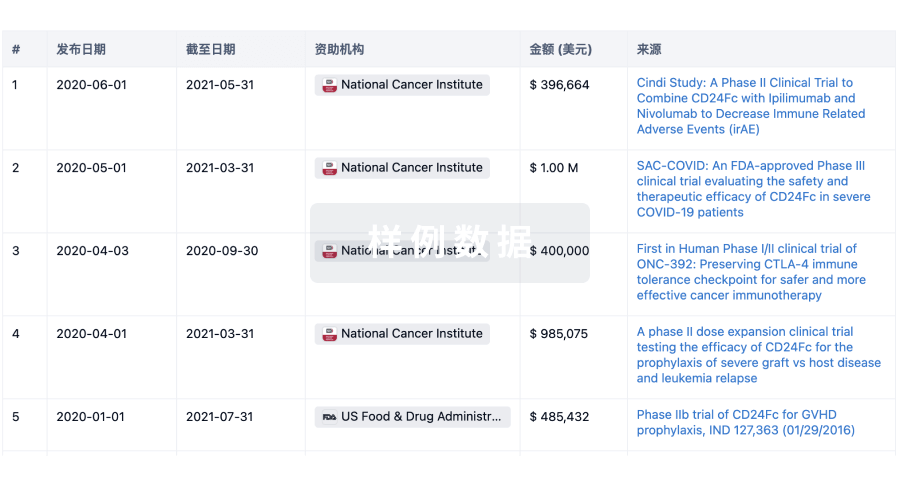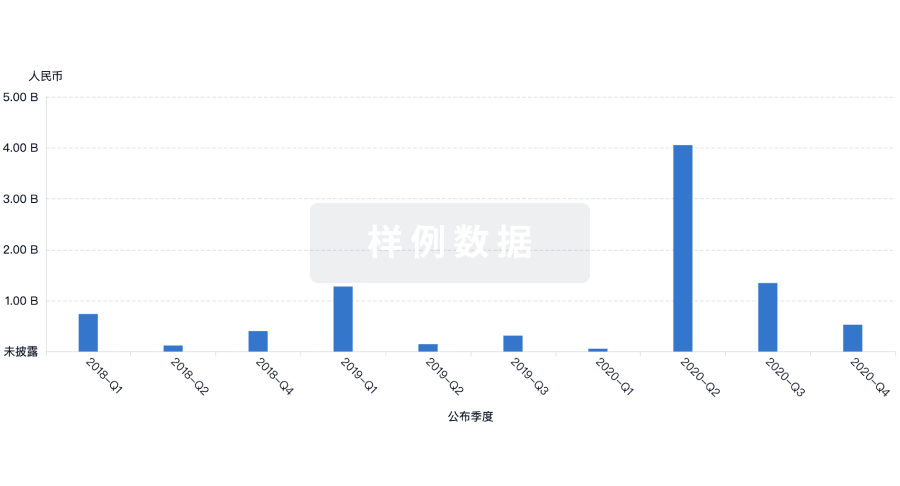预约演示
更新于:2025-08-29

Shandong Simcere Biopharmaceutical Co. Ltd.
山东先声生物制药有限公司|子公司|1999|中国山东省
山东先声生物制药有限公司|子公司|1999|中国山东省
更新于:2025-08-29
概览
标签
肿瘤
呼吸系统疾病
消化系统疾病
双特异性抗体
重组蛋白
单克隆抗体
疾病领域得分
一眼洞穿机构专注的疾病领域
暂无数据
技术平台
公司药物应用最多的技术
暂无数据
靶点
公司最常开发的靶点
暂无数据
| 排名前五的药物类型 | 数量 |
|---|---|
| 重组蛋白 | 2 |
| 双特异性抗体 | 2 |
| 生物药 | 1 |
| 单克隆抗体 | 1 |
关联
6
项与 山东先声生物制药有限公司 相关的药物靶点 |
作用机制 VEGFR拮抗剂 |
在研机构 |
原研机构 |
最高研发阶段批准上市 |
首次获批国家/地区 中国 |
首次获批日期2005-09-12 |
靶点 |
作用机制 BTLA刺激剂 |
在研机构 |
原研机构 |
在研适应症 |
非在研适应症- |
最高研发阶段临床1期 |
首次获批国家/地区- |
首次获批日期- |
靶点- |
作用机制- |
在研机构 |
原研机构 |
在研适应症 |
非在研适应症- |
最高研发阶段临床1期 |
首次获批国家/地区- |
首次获批日期- |
5
项与 山东先声生物制药有限公司 相关的临床试验CTR20210869
重组人血管内皮抑制素注射液(恩度®)联合顺铂对比安慰剂联合顺铂腔内注射治疗恶性胸腹腔积液的随机、对照、双盲的多中心Ⅲ期注册临床研究
主要研究目的
与安慰剂联合顺铂腔内注射比较,以无穿刺和/或引流生存期(Puncture /drainage-Free Survival, PuFS)为指标评价恩度®联合顺铂腔内注射治疗恶性胸腔或腹腔积液的疗效。
次要研究目的
与安慰剂联合顺铂腔内注射比较,以6个月总生存率为指标评价恩度®联合顺铂腔内注射治疗恶性胸腔或腹腔积液的生存获益(关键次要研究目的);
与安慰剂联合顺铂腔内注射比较,以WHO胸腹腔积液疗效标准评价的胸腹腔积液客观缓解率、3个月无穿刺和/或引流率,至下一次穿刺和/或引流时间(TTNP)、12个月OS率及OS为指标,评价恩度®联合顺铂腔内注射治疗恶性胸腔或腹腔积液的疗效;
与安慰剂联合顺铂腔内注射比较,以干预前、后患者报告结局(PRO)评分变化评估的恩度®联合顺铂腔内注射治疗恶性胸腔或腹腔积液对受试者症状及生活质量的变化;
与安慰剂联合顺铂腔内注射比较,评价恩度®联合顺铂腔内注射治疗恶性胸腔或腹腔积液的安全性。
开始日期2021-07-21 |
申办/合作机构 |
CTR20200345
聚乙二醇化重组人血管内皮抑制素在晚期/转移性非小细胞肺癌或其他实体瘤的安全性、耐受性和药代动力学研究
主要目的:评价PEG-ENDO治疗晚期/转移性NSCLC或其他实体瘤的安全性、耐受性及药代动力学特征,确定PEG-ENDO联合化疗的后续临床试验推荐剂量。 次要目的:初步评价PEG-ENDO联合化疗在晚期/转移性NSCLC或其他实体瘤治疗中的临床疗效。
开始日期2020-04-15 |
申办/合作机构  江苏先声药业有限公司 江苏先声药业有限公司 [+3] |
CTR20150315
射用人源化抗VEGF单克隆抗体联合FOLFIRI方案治疗转移性结直肠癌患者的安全性、耐受性和药代动力学的Ib期临床试验
主要目的:评价不同剂量赛伐珠单抗联合FOLFIRI方案治疗转移性结直肠癌患者的安全性及耐受性,推荐后续临床试验给药剂量和给药方案。
次要目的:分析赛伐珠单抗联合FOLFIRI治疗转移性结直肠癌患者的药代动力学特征;按照RECIST标准初步评估赛伐珠单抗联合FOLFIRI方案的抗肿瘤活性;检测血浆VEGF、抗赛伐珠单抗抗体滴度。
开始日期2015-10-13 |
申办/合作机构  江苏先声药业有限公司 江苏先声药业有限公司 [+3] |
100 项与 山东先声生物制药有限公司 相关的临床结果
登录后查看更多信息
0 项与 山东先声生物制药有限公司 相关的专利(医药)
登录后查看更多信息
3
项与 山东先声生物制药有限公司 相关的文献(医药)2025-04-01·INVESTIGATIONAL NEW DRUGS
Anti-PD-L1 envafolimab combined with anti-VEGF suvemcitug in pretreated solid tumors and hepatocellular carcinoma: an open-label phase II study with safety run-in stage
Article
作者: Jiang, Da ; Su, Fang ; Liu, Zhenru ; Hao, Chunyi ; Cheng, Ying ; Fan, Qingxia ; Lu, Liqin ; Sun, Xiyang ; Zhang, Yu ; Sun, Shuguang ; Tian, Ji ; Yang, Chen ; Ma, Lixia ; Fang, Yong
BACKGROUND:
Immune checkpoint inhibitors (ICIs) combined with anti-vascular endothelial growth factor (VEGF) have been the standard first-line treatment of hepatocellular carcinoma (HCC). However, the efficacy of this combination in post-line treatment is still unknown. This study aimed to evaluate the efficacy and safety of the combination of anti-PD-L1 envafolimab and novel humanized anti-VEGF suvemcitug as second-line treatment for patients with HCC.
METHODS:
This open-label, prospective phase II clinical study (NCT05148195) comprised safety run-in stage and dose expansion stage of HCC cohort. Eligible patients were aged ≥ 18 years and had undergone at least a prior line of treatment. Patients received fixed-dose envafolimab and suvemcitug until termination of disease progression, unacceptable toxicities, or withdrawal. The primary endpoint of safety run-in stage was recommended dose (RD), and dose expansion stage was objective response rate (ORR).
RESULTS:
As of August 10, 2023, no dose-limiting toxicity was observed in six patients in the safety-run-in stage, and 2 mg/kg dose every 3 weeks was declared the RD of suvemcitug. Among 20 patients with HCC, the median age was 54.5 (range, 42-70) years. Of these patients, 20 (100.0%) received ≥ one prior line treatment, with 20 (100%) received tyrosine kinase inhibitor (TKI) treatment and 8 (40.0%) received prior ICI treatment. The ORR was 10.0% (95% confidence interval (CI), 1.2-31.7), DCR was 65.0% (95% CI, 40.8-84.6), and DoR was not reached (NR). With a median follow-up of 13.9 months, the median progression-free survival (PFS) and median overall survival (OS) were 4.3 months (95% CI, 1.4-8.1) and 10.7 months (95% CI, 6.0-not evaluable [NE]), respectively. Treatment-related adverse events (TRAEs) of grade ≥ 3 occurred in 40% patients, with proteinuria (20.0%, 4/20) being the most frequent. The ORR of no lung metastasis, prior first-line treatment and IO naïve treatment subgroup was 16.7%.
CONCLUSIONS:
The combination of envafolimab and suvemcitug showed a tolerable safety profile and promising antitumor activity in HCC patients who failed later-line treatment.
2024-08-01·GYNECOLOGIC ONCOLOGY
Suvemcitug plus chemotherapy for platinum-resistant epithelial ovarian, fallopian tube and primary peritoneal cancer: A phase 1b dose-escalation trial
Article
作者: Zheng, Hong ; Sun, Haolin ; Wu, Yan ; Zhang, Keqiang ; Yuan, Guangwen ; Zhang, Jiajing ; Sun, Xiyang ; Wu, Lingying
OBJECTIVE:
The use of bevacizumab has been hampered by safety concerns despite demonstrable progression-free survival (PFS) benefit in subjects with platinum-resistant ovarian cancer, highlighting the need for novel effective and safe antiangiogenic agents. This study aimed to characterize the tolerability, safety, and antitumor activities of escalating doses of anti-VEGF antibody suvemcitug plus chemotherapy in platinum-resistant ovarian cancer patients.
METHODS:
This open-label, dose-escalation trial enrolled adult patients (≥18 years) with platinum-resistant histologically or cytologically-confirmed epithelial ovarian, fallopian tube and primary peritoneal cancer. Eligible patients received paclitaxel or topotecan plus escalating doses of suvemcitug 0.5, 1, 1.5, or 2 mg/kg once every two weeks. The primary endpoints were safety and tolerability, and antitumor activities of suvemcitug.
RESULTS:
Twenty-nine subjects received paclitaxel (n = 11) or topotecan (n = 18). No dose-limiting toxicities occurred. The most common adverse events of special interest were proteinuria (41.4%), hypertension (20.7%) and epistaxis (10.3%). No gastrointestinal perforations occurred. Nine subjects (31.0%, 95% CI 15.3-50.8) demonstrated investigators-confirmed objective response, including complete response in 1 and partial response in 8. The median PFS was 5.4 months (95% CI 2.2-7.4).
CONCLUSIONS:
Suvemcitug demonstrated an acceptable safety profile and promising antitumor activities in platinum-resistant ovarian cancer patients, supporting its further clinical development.
2023-06-01·ESMO open
Suvemcitug as second-line treatment of advanced or metastatic solid tumors and with FOLFIRI for pretreated metastatic colorectal cancer: phase Ia/Ib open label, dose-escalation trials
Article
作者: Zhang, Y ; Feng, X ; Ji, D ; Zhang, J ; Cao, J ; Xu, N ; Wu, Y ; Mao, C ; Liu, L ; Song, W ; Ding, Y ; Song, L
BACKGROUND:
Suvemcitug (BD0801), a novel humanized rabbit monoclonal antibody against vascular endothelial growth factor, has demonstrated promising antitumor activities in preclinical studies.
PATIENTS AND METHODS:
The phase Ia/b trials investigated the safety and tolerability and antitumor activities of suvemcitug for pretreated advanced solid tumors and in combination with FOLFIRI (leucovorin and fluorouracil plus irinotecan) in second-line treatment of metastatic colorectal cancer using a 3 + 3 dose-escalation design. Patients received escalating doses of suvemcitug (phase Ia: 2, 4, 5, 6, and 7.5 mg/kg; phase Ib: 1, 2, 3, 4, and 5 mg/kg plus FOLFIRI). The primary endpoint was safety and tolerability in both trials.
RESULTS:
All patients in the phase Ia trial had at least one adverse event (AE). Dose-limiting toxicities included grade 3 hyperbilirubinemia (one patient), hypertension and proteinuria (one patient), and proteinuria (one patient). The maximum tolerated dose was 5 mg/kg. The most common grade 3 and above AEs were proteinuria (9/25, 36%) and hypertension (8/25, 32%). Forty-eight patients (85.7%) in phase Ib had grade 3 and above AEs, including neutropenia (25/56, 44.6%), reduced leucocyte count (12/56, 21.4%), proteinuria (10/56, 17.9%), and elevated blood pressure (9/56, 16.1%). Only 1 patient in the phase Ia trial showed partial response, [objective response rate 4.0%, 95% confidence interval (CI) 0.1% to 20.4%] whereas 18/53 patients in the phase Ib trial exhibited partial response (objective response rate 34.0%, 95% CI 21.5% to 48.3%). The median progression-free survival was 7.2 months (95% CI 5.1-8.7 months).
CONCLUSIONS:
Suvemcitug has an acceptable toxicity profile and exhibits antitumor activities in pretreated patients with advanced solid tumors or metastatic colorectal cancer.
430
项与 山东先声生物制药有限公司 相关的新闻(医药)2025-08-27
·药通社
8月25日,海南先声药业提交了两条盐酸达利雷生片的上市申请,注册分类4类,为一致性评价受理号。
两个月前的6月17号,盐酸达利雷生片刚刚在国内获批,持有人是Idorsia Pharmaceuticals Deutschland GmbH,境内责任人:海南先声药业有限公司。
早在2022年 11 月,先声药业集团就和Idorsia签订了达利雷生在中国的开发独家许可协议。
那这次是什么?自己仿制自己独家的品种么?
↓ 扫码加入药通社交流群 ↓
达利雷生片是一款双重食欲素受体拮抗剂,新一代抗失眠药物,最大的特点是无成瘾性,不受精神药品管辖,同类型产品有苏沃雷生、达利雷生、莱博雷生三款,苏沃雷生国内未上市,也暂无审评进度,达利雷生直接竞争品种就只剩下了卫材药业的莱博雷生。
莱博雷生由原研卫材药业自行推广,达利雷生片则是先声药业负责国内运营,国内助眠类药物市场广阔,先声药业显然很看好这一品种,或将成为先声药业下一个爆品。
针对先声药业提交的上市申请,业内有两种看法:
第一种:这只是正常原研地产化操作。
7月31日,先声就提交了该品种的优先审评,纳入优先审评原因里写得很清楚,依据是《国家药监局关于优化已在境内上市的境外生产药品转移至境内生产的药品上市注册申请相关事项的公告》纳入。
为了保证境内产品供应,境外持有人确实会进行原研地产化,CDE鼓励进行原研地产化,一般是由持有人的境内子公司来进行,先声药业作为合作伙伴,能进行地产化申报应当是协商的结果。
类似的产品如云顶新耀的布地奈德肠溶胶囊,同样跟Calliditas Therapeutics签订国内独家授权许可协议,就只做了增加境内生产地址的补充申请。
此次仿制先声药业发布了2类专利声明,仿制药申请人已获得专利权人相关专利实施许可。
第二种:这或是先声药业为了实现市场“一鱼两吃”。
另外一部分业内则认为,先声药业是准备将盐酸达利雷生片进行“一鱼两吃”,原研(商品名:科唯可®)和先声制药仿制品种进行差异化运营。
同时推测先声仿制上市的盐酸达利雷生片会是另一个商品名,价格上和渠道上也会有区分,可以完成更多的使用人群覆盖。
这类商业化布局也不是先例,北京泰德的氟比洛芬凝胶贴膏,当年就是代理了原研泽普思®的同时自主研发了得百安®,双双推向市场,用以完成更广的使用人群覆盖,创造出了单品卖出30亿的传奇。
达利雷生片在国内的化合物专利要到2033年才会到期,意味着除了获得授权的先声药业,其余仿制企业短时间内没有参与竞争的可能性。
莱博雷生比达利雷生早二十天在国内获批,8月已正式上市销售,抢占了先机,更早一点,2021年6月,莱博雷生就已在中国香港上市,得益于“港澳药械通”政策,2023年1月广州就已开出首张该品处方。
先声药业此次布局,或许也是为了从覆盖面上胜过莱博雷生?
达利雷生和莱博雷生上市时间接近,同时通过了2025年国谈目录资格审查,或许这两款品种会被双双纳入国谈。
真正的竞争才刚刚开始!
参考:医药专利、北京药研会
⭐ 关注药通社,获取行业最前沿资讯
投稿/企业合作/内容沟通:
药通社总编—华籍美人(Ww_150525)
*添加请注明备注及来意
一致性评价优先审批引进/卖出
2025-08-19
点击蓝字
关注我们
本
期
看
点
针对于热钱涌入医药板块后涌起来的一众幺蛾子事件,不胜枚举。在热钱退出后,裸泳者显现。市场对于不及预期或者存在“暗箱操作”的BD交易,利好不及预期即为利空。药物研发有其深刻的时间效应,不是短期可以热炒的板块。也期望市场日趋理智之后,让浮躁的行业从业者重拾务实本分之心, 潜心创新研发。
本期内容
01
荣昌生物丨眼科用药RC28-E
02
荣昌生物丨泰它西普丨BD速递
03
荣昌生物丨PD-1/VEGF双抗
04
总结与展望
【01 荣昌生物丨眼科用药RC28-E】
2025年8月19日,荣昌生物与参天制药全资子公司参天中国签署协议,将自主研发的VEGF/FGF双靶点融合蛋白药物 RC28-E注射液 在大中华区及部分亚洲国家(含韩国、泰国、越南、新加坡、菲律宾、印尼、马来西亚)授予其独家开发、生产和商业化权利,荣昌保留全球其他地区权益。
协议约定:荣昌将获 2.5亿元首付款,最高 5.2亿元开发及监管里程碑款,最高 5.25亿元销售里程碑款,并按销售额获得 高个位数至双位数比例分成。
临床进展方面,RC28-E已在 ARVO 2025公布Ⅱ期DME临床数据,显示显著改善视力和黄斑水肿。其 DMEⅢ期已完成随访,预计2025年下半年申报国内上市;wAMDⅢ期在研,预计2026年上半年申报。
参天制药是日本百年眼科药企,在全球眼科处方药及器械领域居领先地位。
荣昌生物加速BD,正在新的领域迎来突破。
02 荣昌生物丨泰它西普丨BD速递
美东时间2025年6月25日,市场久等的荣昌生物宣布,将公司具有自主知识产权的泰它西普有偿许可给美国纳斯达克上市公司Vor Biopharma Inc.,Vor Bio将获得泰它西普在除大中华区以外的全球范围内开发、生产和商业化的独家权利;荣昌生物将取得Vor Bio价值1.25亿美元现金及认股权证(包括4500万美元的首付款和价值8000万美元的认股权证,认股权证可以每股0.0001美元认购Vor Bio 3.2亿股的普通股,约占Vor Bio经扩大总发行股本的23%)、最高可达41.05亿美元的里程碑付款,总金额42.3亿美元,此外荣昌生物还将收到高个位数至双位数销售提成款。
上述内容,只需要看首付款就行了,至于股权认证等 ,看不懂。消息一经发出,也导致市场反应强烈,股价大跌16%,反映了前期过高的BD期待泡沫破裂。
泰它西普(RC18,商品名“泰爱®”)
荣昌生物凭借自主研发的泰它西普成为国内免疫创新药领域的亮眼新星。
2025年5月27日,NMPA正式批准泰它西普新增治疗抗乙酰胆碱受体抗体阳性成人全身型重症肌无力(gMG)适应症(继系统性红斑狼疮、类风湿关节炎后第三个获批适应症),也意味着这款药物有望成为国产免疫药向国际MNC(跨国药企)争取高价BD(对外授权合作)的重要筹码。然而,要想实现“高溢价”BD,之前的文章多次写过 ,泰它西普还必须踏过几道关键性“坎”。
详情见:
荣昌生物泰它西普想实现高价BD,必须迈过的几道“坎”
泰它西普高溢价BD面临的挑战
1)起效慢,难与竞品抗衡与Agomab(4周显效)相比,泰它西普需12周才能达到相同MG-ADL改善幅度;双靶机制是否能带来更快或更稳的疗效,仍缺乏有力证据。简言之,泰它西普在深度缓解和持续疗效方面表现极其亮眼:长疗程下的高效降抗体能力与良好耐受性为其赢得慢性维持治疗市场奠定基础。
2)缺乏海外临床数据目前仅有国内III期结果,尚未启动欧美注册研究。若无跨区域有效性/安全性数据,将影响MNC对其全球开发和申报的信心。
3)竞争激烈、节奏滞后面临MNC企业产品的竞争:
强生加入阿斯利康、优时比行列,重磅FcRn抗体获FDA批准上市 若泰它西普推进节奏慢,后发优势不足,难以获得“独家”定价逻辑支撑。
以上因素限制了泰它西普被MNC看中的可能。
03 荣昌生物丨PD-1/VEGF双抗
昨天文章我们聚焦了荣昌生物:
亟需BD刺激的荣昌/君实,联手申请新适应症、
石药、先声之后,荣昌生物BD也爆了,市场反应日趋理性,本号一直关注荣昌生物这久等不来的BD,不曾想,在已经非常内卷的PD-1/VEGF双抗赛道 ,荣昌生物呈现出一定的吸引力出来,会否获得MNC的青睐呢?
首先,汇总下近期利好消息。
2025年8月8日,RC148获FDA批准在美国开展针对多种晚期恶性实体瘤的Ⅱ期临床试验,标志着其正式进入全球开发阶段。
来源:CDE 官网
2025年8月11日,中国CDE拟将RC148纳入突破性疗法品种,适应症为联合多西他赛治疗经PD-1/PD-L1抑制剂和含铂化疗失败的驱动基因阴性晚期非小细胞肺癌。
来源:荣昌生物官网
荣昌生物RC148凭借中美双报策略和突破性疗法认定,在PD-1/VEGF双抗赛道已跻身全球第一梯队。其差异化布局(如NSCLC后线治疗、TNBC联合疗法)和国际化潜力(美国Ⅱ期启动、BD合作预期)有望加速商业化进程,成为继泰它西普后下一个可能的BD产品。未来半年临床数据披露将是关键催化剂。相信更多的MNC也在密切关注着国内一众产品的进度。
04 总结与展望
当热钱涌入医药板块,这一本需长期投入方能收获回报的领域,市场却以短期炒作风气追捧个股,待股价攀升便逢高出货。人们曾以为这种投机热潮能持续更久,然而其消退之迅速远超预期。年初时,BD 项目尚属正常,而到了本月,市场乱象丛生,各种异常操作频现,宛如置身其他板块。医药行业原本需要潜心研发的务实风气遭到严重冲击,一片混乱。在快速迭代的创新药赛道上,任何一次“画饼”都不应成为企业长久经营的主要策略。
★
引进/卖出临床2期
2025-08-19
重磅路演推荐
项目名称:靶向恶性肿瘤干细胞的创新抗癌药
项目所在地:上海
适应症:脑胶质瘤、胰腺癌等恶性肿瘤
项目需求:
为两个新药管线的临床一期试验募集4000万资金。
公司简介
上海施江生物科技有限公司基于恶性肿瘤干细胞的全新特异性靶点,研发可安全有效杀伤肿瘤干细胞的线粒体特异性抑制剂,以解决恶性肿瘤复发这一临床难题,有望显著延长患者生存期。在研药物可用于脑胶质瘤、胰腺癌、三阴乳腺癌、小细胞肺癌等多种恶性肿瘤,具有广谱抗癌属性。公司计划于2025年下半年提交脑胶质瘤药物的中美IND申请,进入临床研究阶段。施江生物致力于为尚无有效治疗手段的恶性肿瘤提供创新解决方案,成为新一代肿瘤代谢类药物研发的引领者。
项目名称:安全长效的增肌减脂双适应症ASO
项目所在地:深圳
适应症:增肌、减肥、代谢性脂肪肝MAFLD、心力衰竭
项目需求:
1、需求:2000-2200万
2、投资架构:比较开放,可以是newCo,lisence out,共研co-dev,或者是平台公司加轮。
3、融资目标:全力推进项目至IND阶段,达成临床转化的关键里程碑。
公司简介
深圳市硬核酸生物科技有限公司,是一家创新核酸药物开发企业。基于物理第一性原理与全球领先的AI模型,公司优化反义寡核苷酸ASO的ADME特性,实现无需LNP包被或配体介导的器官靶向富集。目前,平台已在肌肉、脂肪、肾脏、肝脏、肺及中枢神经系统等器官取得显著成果。公司自创立以来,持续获得全球顶尖IT/BT企业与药企的战略关注及孵化支持。核心业务聚焦慢性病治疗领域,同时提供混合型服务。
项目名称:吸入双抗和三抗的创新之路
项目所在地:深圳
适应症:哮喘和慢阻肺
项目需求:
融资,合作开发和对外授权
公司简介
瑞思普利是一家集研发、生产、销售为一体的综合性创新型生物制药企业。公司目标是成为吸入药物研发和生产的领军企业。自研产品包括高端复杂吸入粉雾剂管线,重点领域聚焦在呼吸系统疾病,如哮喘,慢阻肺,特异性肺纤维化和肺动脉高压的吸入粉雾剂药物的仿制和创新药的研发。此外,公司还可以对外赋能:接受高端复合吸入粉剂(OEM)代工制造的委托;吸入型产品的定制开发(将常规剂型转化为可吸入剂型); 新型分子实体吸入药物递送系统的概念验证研究。
河络新图生物科技(上海)有限公司
项目名称:iPSC分化的异体血小板的研发
项目所在地:上海
适应症:化疗引用的血小板减少、外科手术、原发性血小板减少
项目需求:
1.共同开发iPSC衍生的血小板
2.创新止血和抗血小板新药的早研
3.人造血小板与其它止血剂的联合应用
4. 人造血小板及衍生产品对外授权
5. 人造血小板衍生产品在医美领域的合作与开发
公司简介
河络新图成立于2021年,创业团队由美国麻省理工学院和英国剑桥大学归国学者领衔,是一家定位于iPSC定向分化、基因编辑、规模化细胞产品制备及细胞治疗技术开发为目标的高科技创新型企业。河络新图在iPSC领域以多年创新的细胞定向分化技术解决再生医学领域的核心问题和临床需求, 倾力打造人工血液制备平台, 同步建设全球领先的再生医学细胞产品开发体系。公司研发团队由来自于海内外著名高校和研究机构的青年学者和拥有多年产业经验的杰出人才组成,团队在干细胞、转化医学领域均拥有丰富的科研及产业经验。公司正在开展人工血小板的研究者发起性临床试验,初步结果显示产品安全有效。
浙江霍德生物工程有限公司
项目名称:针对脑卒中、颅脑损伤等运动障碍后遗症的异体通用型iPSC衍生神经前体细胞治疗产品
项目所在地:中国杭州市,美国休斯敦
适应症:缺血性脑卒中偏瘫后遗症、出血性脑卒中偏瘫后遗症、颅脑损伤后遗症、脑瘫、癫痫
项目需求:
1. 商业合作:寻求与全球知名药企的hNPC01产品的海外共同开发或商业化授权合作,加速产品上市及销售。
2. 融资:近期将完成C轮融资,用于支持hNPC01产品的海外多中心的确证临床和商业化。
3. 宣传:对于脑卒中等未被满足的巨大临床需求和潜在重磅细胞药物临床突破性数据、加速路径等进行宣传;欢迎更多优秀的人才加入和各种合作。
公司简介
霍德生物于2017年1月成立,是一家专注于开发iPSC衍生通用型神经细胞治疗产品的全球创新生物技术公司,在杭州拥有细胞药物研发中心、GMP细胞生产车间与质控中心和办公场地。霍德生物在iPSC重编程、多能干细胞神经分化及细胞工程方面具有领先的全球专利及创新技术优势,建立了iPSC细胞产品CMC平台,悬浮自动生产工艺和多种创新分析方法。霍德生物拥有多款神经细胞在研产品,其中首个人前脑神经前体细胞注射液hNPC01是全球首个获中美注册临床默许的多能干细胞品种,已完成针对脑卒中偏瘫后遗症的中国I期注册临床,治疗效果支持其为潜在的BIC,可拓展颅脑损伤后遗症、脑瘫、癫痫等重大未被满足的临床需求。霍德生物成立以来已完成多轮由高瓴投资、礼来亚洲等领投的数亿元融资。
河南知微生物医药有限公司
项目名称:1类新药BTK抑制剂TM471-1的研究与开发
项目所在地:河南省新乡市凤泉区产业集聚区
适应症:非霍杰金淋巴瘤及自身免疫性疾病
项目需求:
1.融资需求:计划融资 15000 万元,主要用于BTK抑制剂TM471-1后续临床试验推进、研发团队扩充以及生产设施筹备等方面,加速产品上市进程。
2.合作拓展:与上海及长三角地区的科研机构、高校、药企等建立合作关系,实现资源共享、优势互补,共同开展新药研发、临床试验合作等项目。
3.对接BD:与相关国内外BD人士对接,寻求项目License out。
公司简介
河南知微生物医药有限公司于 2016 年 11 月 15 日成立,总部位于新乡市凤泉区产业集聚区,在上海张江药谷建有研发中心。
公司由新乡王氏集团与李伟教授和留美博士丁清杰(原 Roche 首席科学家)科研团队联合创建,并与河南师范大学达成战略合作。其业务主要涵盖抗癌类创新药物研发、高端原料药及其制剂研发,以及相关领域技术服务。在科研实力上,组建了包含博士、硕士等50多人的专业团队,打造了1类创新药从药物发现、工艺优化、临床前研究、临床试验、申报注册等各个环节全贯通的高端创新技术平台,配备先进实验仪器,建成超 6000 平方米综合实验室。公司已取得5项 PCT 国际专利,拥有三个一类创新药临床批文。先后获得河南省新型研发机构、河南省抗癌新药工程研究中心等资质。
项目名称:Pan-RAS (ON) Tri-complex Molecular Glue Inhibitor
项目所在地:上海
适应症:实体瘤
项目需求:本项目聚焦 pan-RAS 通路创新药物开发,目前处于临床前研究阶段,已完成靶点验证、化合物筛选及初步药效学研究。项目核心优势包括:针对 RAS 突变(如 G12C/D/V、G13D等热点亚型)的广谱抑制机制,通过高选择性小分子抑制剂突破传统 RAS 靶点 “不可成药” 瓶颈;在多种肿瘤模型(如 NSCLC、PDAC、CRC)中展现显著抗肿瘤活性,联合用药方案(如与免疫检查点抑制剂联用)可进一步增强疗效;药代动力学特性优异,具备口服生物利用度高、体内代谢稳定等成药潜力。
现寻求全球范围内的合作伙伴,合作模式包括但不限于:海外市场权益转让、全球联合开发、技术共建及商业化合作。期望合作伙伴具备以下条件:在肿瘤领域有丰富的药物开发经验及国际化注册能力,拥有成熟的临床试验网络及商业化渠道,可提供资金、技术或资源支持以推进项目临床转化。项目方将提供完整的临床前研究数据(含药效、药代、安全性评价报告)及技术转移支持,与合作伙伴共同探索 pan-RAS 靶向药物的全球市场价值,推动创新疗法惠及更多肿瘤患者。
公司简介
荣昌制药成立于1993年,总部位于中国烟台,是一家集研发、生产、销售、服务为一体,横跨现代中药、小分子和生物制药、生物药物研发和生产服务(CDMO)、生物医药企业和项目孵化四大领域的现代化制药企业。公司的创始人和管理团队拥有多年顶尖跨国药企的研发和管理经验,并参与了多个临床及上市新药的研发。多年来成立的子公司和分拆公司包括荣昌生物、业达国际生物医药创新孵化中心、烟台迈百瑞国际生物、烟台赛普生物、荣昌制药(淄博)等。荣昌制药小分子研发板块专注于肿瘤新药研发,以肿瘤靶向精准治疗和肿瘤免疫治疗药物为核心,致力于开发生物学机制清晰,具有重大未满足临床需求的潜在first-in-class或best-in-class创新药物,现已形成涵盖实体瘤、血液瘤的研发管线布局。
项目名称:转录因子蛋白质原创药诱导细胞转化癌症治疗项目
项目所在地:江苏省苏州市
适应症:肝癌、胃癌
项目需求:苏州复恩特药业(美国Qurgen中国全资子公司)依托全球首创“QQ-蛋白质诱导原位组织重编程技术”,开发不杀死癌细胞而将其转化为正常细胞的颠覆性疗法。现寻求战略投资方、跨国药企BD合作及临床资源支持,加速中国临床试验进展及产业化进程。
1、核心需求如下:
1) 第二轮融资1.5-2亿人民币
估值基准:投前15亿人民币。
用途:
✔ 80%用于中国一期临床(肝癌/胃癌适应症)试验,进入二期临床试验;
✔ 20%投入储备项目的研发(糖尿病、慢性心衰、卵巢早衰、肺纤维化等项目);
2) 寻找战略合作开发伙伴:开展深度合作,采用:授权开发、共同开发的形式,共同开发新药管线。
2、技术优势背书
全球唯一转录因子成药的临床转化:SON-DP注射液获FDA/CDE双批准,实现“肿瘤组织原位转化”(活检显示35%-100%癌组织转正常);
专利壁垒:3项核心技术专利(零竞品对标)。
公司简介
苏州复恩特药业是一家专注于蛋白质生物制药的企业,着重于开发原创转录因子抗肿瘤药物和转录因子药物治疗目前无根治疗法的重大疾病。 公司的创新型转录因子抗肝癌、抗胃癌蛋白质药物是一款诱导体内肿瘤组织原位重编程药物。其原理是将癌细胞转化为正常细胞,从而治疗实体瘤,为癌症患者提供安全、有效且可负担的治疗方案。2024年10月15日,公司已获得中国国家食药局药审中心一期临床试验许可(IND)。2025年3月,公司已启动抗肝癌药、抗胃癌药一期临床试验,目前已开展6例患者给药。凭借具有自主知识产权的突破性技术平台,苏州复恩特药业正在领导开创抗肿瘤药物临床研究和晚期肿瘤治疗的新时代。
更多路演申请
路演时间:2025年8月29日
路演形式:路演-需求快闪
路演-早期/晚期项目
每位项目方15mins
参会人群:公司管理层:董事长、总裁、首席执行官、总经理、首席战略官、首席商务官、首席投资官、首席医学官、院长、协会会长、合伙人
申报截止时间:2024年8月22日
报名抢占黄金席位即可获得
跨国药企战略合作直通车
让您的创新项目一键接入全球TOP药企资源库,开启跨国技术合作与联合研发新机遇。
顶级投资机构优先观察名单
直通头部资本视野,加速融资进程,抢占生物医药赛道制高点。
全球交易范式全解析
深度掌握前沿BD模式、跨境并购策略与IP授权逻辑,解锁生物医药产业全球化布局密码。
2025(第九届)亚太生物医药合作峰会
全球协同创新 多元开放合作
2025年8月28日-29日 中国 · 上海
生物医药 BD 领域风云际会,波澜壮阔。在这种中国资产迈向国际化的大时代下在这样一个狂风骤雨的时代环境中,药企如何加速国际化进程?如何通过多元化合作,加速协同创新?盈利曙光下,创新药企如何通过现金流大考?--都成为企业不得不思考的问题。
基于此,由上海士研咨询主办,苏比亚SUBIA和雅法资本支持举办的Bio PartneringAPAC 2025(第九届)亚太生物医药合作峰会以“全球协同创新,多元开放合作”为主题,定于2025年8月28-29 日·上海(周四、周五)召开。重点聚焦药企如何在全球化浪潮中把握确定性,实现国际化战略宏图,以寻求新的增量;加快药企国际市场布局,深度探索产品商业化的机遇与挑战;同时,我们也会邀请来自亚洲各国家乃至全球的最前沿技术的创新药企参与,分享各自国家和地区的先进技术和成功案例,积极寻求更多全球合作新机遇,深度探索“合作”为医药生态圈带来的更多可能。
扫描上方二维码咨询报名/赞助/合作/路演
工作人员会在1-2天内联系您
已确认嘉宾信息
刘东舟
首席科学官、创新药全球研发中心总经理,华东医药股份有限公司
南开大学化学/生物化学/免疫学学士、博士,美国纽约州立大学石溪分校 MBA,曾在美国北卡大学教堂山分校药学院、美国肯塔基州路易斯维尔大学医学院等进行医学、药学博士后研究。具有30年海内外创新药研发工作经验,在药物发现、转化医学和临床开发积累了丰富的经验。曾在美国GSK(葛兰素)、Wyeth(惠氏)等公司担任关键研发部门负责人。2020年加入华东医药担任公司首席科学官兼创新药全球研发中心总经理,负责创新药研发工作。
曾发表130多篇研究文章/学术会议摘要及主题演讲,申请50余项创新药专利(8项授权)。海外高层次人才认定专家;浙江省“领军型创新团队”带头人,主持多项政府科技项目;中国药促会专委,中科院合肥物质所特聘教授,浙大特聘客座教授、(国家级)博士后科研工作站导师。
陈波
首席科学家、科委会副主任,华润医药集团
陈波博士是海外高层次人才特聘专家,目前担任华润医药集团首席科学家, 在生物技术和制药行业拥有超过20年的国际职业生涯,包括在美国NIH,AstraZeneca等顶尖科研机构和制药公司从事基础研究和新药研发团队领导者的工作经历,具有从靶点发现到临床开发和商业运作的整个研发价值链的研发背景。他博士毕业于中国人民解放军空军军医大学,在美国NIH完成博士后,其后还获得美国Hood College工商管理硕士学位。他迄今在著名期刊上发表国际学术论文,专著章节和专利共30余篇,包括发表在Annals of the Rheumatic Diseases, Nature Communication, Nature Immunology, Nature Medicine, PNAS 等顶尖杂志上的论文。并曾获得了卫生部的科技进步二等奖,AstraZeneca的员工白金奖和银奖,NIH的卓越研究员奖,齐鲁制药集团的卓越领导奖等。
周高波
首席投资官,先声药业
周高波,先声药业首席投资官,负责公司对外合作和战略。加入先声药业之前,周高波先生在麦肯锡公司担任全球董事合伙人和大中华区医疗咨询联席负责人,拥有十五年医疗行业管理咨询经验。他一直致力于为领先的制药、生物科技、医疗器械、生命科学投资公司提供战略和管理咨询服务,深入探索中国医改和创新环境下的企业战略、创新商业模式、数字化转型、投资合作,并组建了行业内最大的医疗领域管理咨询团队。此前,他在人类基因组科学公司(HGSI)亦从事过抗体和融合蛋白药物的研发工作。
周高波先生拥有杜克大学商学院的工商管理硕士学位,马里兰大学生物化学硕士学位和复旦大学的遗传学本科学位。
佟玲
BD负责人/ 创新拓展副总经理,步长制药
理学博士,国家“131”第一层次创新人才,拥有16年医药研发经验,10年BD交易和联盟管理经验。曾在天士力医药主导完成与法国Pharnext、美国礼来、日本EA等国际合作。加入步长后,组建了生物药BD团队,推动BC001、Fc-EPO等项目成功出海到俄罗斯、东南亚等国家,并主导了步长与天坛神经外科研究所、佑嘉生物、美国REMD等机构的战略合作。在BD规划、产品线优化以及联盟建设领域积累了丰富经验。
许倩
医学副总裁,金赛药业
许倩博士毕业于新加坡国立大学,取得医学博士学位,并在加州大学完成博士后培训,拥有10多年免疫、皮科、心血管相关治疗领域的临床开发经验。
许倩博士在金赛药业负责免疫,皮科,眼科,成人内分泌,女性健康等治疗领域的临床开发工作。在此之前,许倩博士曾就职于罗氏、礼来、诺华、恒瑞医药等大型国际制药公司参与新药临床开发工作。经验涵盖产品的早期评估、CDP 制定、从 FIH到 NDA及上市后医学的全周期。 在加入工业界前,许倩博士有多年临床和科研经验。
曹飞
联合创始人兼首席运营官,应世生物科技(南京)有限公司
曹飞,应世生物联合创始人兼首席运营官,中国生物工程学会精准医学专委会副秘书长。他在医药领域拥有超过近20年的运营、商务拓展与管理工作经验,2015至2018年,他创立并担任北京鼎基生物科技有限公司首席执行官。在此之前,他于2011加入百济神州(北京)生物科技有限公司并担任公司高层管理委员会成员。他的履历还包括博奥生物集团投融资部副总监、葛兰素史克公司大中华区业务拓展经理以及杨森制药公司亚太区业务拓展与外部科学事务负责人等职务。
他本科毕业于北京大学,获生命科学学院和中国经济研究中心双学位。他曾在香港科技大学生物系攻读博士学位,并赴美国宾夕法尼亚大学医学院做访问学者。
杨笛
董事、副总裁,翰宇药业
杨笛,生物科学学士、生物医学硕士、金融财务硕士。拥有超过10年生物制药和医疗器械领域研发、风险投资、证券、及BD经验。2017年加入翰宇药业,历任战略投资高级总监,现任本公司董事、副总裁、董事会秘书,分管证券、BD。
邱婧君
合伙人、全球研发中心副总裁、 生物统计与数据科学部总经理,复星医药
邱婧君博士曾就职于美国耶鲁大学医学院、默沙东(美国Merck)、拜耳和百济神州。
具有不同地区、不同治疗领域临床研究的丰富经验;参与从研发战略规划到临床试验及上市后研究的各重要阶段,包括早研转化与BD尽调项目。十几年来一直组织推动研发试验设计与统计社区的各种活动。
现任中国统计理论与方法专委会、药促会、CSCO等统计专委会委员,并支持不同课题工作小组,包括ICH-E9(R1) WG、Global IFPMA ICH-E20 WG;与多所科研机构建立长期交流合作关系。
姜大为
业务发展总监,上海医药集团业务发展部
上海医药集团业务发展部工作期间,协同各业务团队领导同事,广泛接触各适应症领域和开发阶段的创新药项目和公司,参与完成多项创新和成熟药品项目的对内&对外授权合作项目。加入上海医药集团之前,曾在多家国内生物医药上市公司从事创新药跨境BD和相关工作,参与完成了多个创新药项目BD交易。
高建英
副总裁兼战略联盟管理部及卓越上市部总经理,复星医药
高建英(Jenny Gao)女士现任复星医药战略联盟部总经理及新产品卓越上市部总经理。
高建英(Jenny Gao)女士具有近20年医药行业工作经验,在心血管慢病及特药肿瘤领域负责个多个重磅产品上市及卓越营销,并擅于国际战略合作及产品全生命周期管理。
黄薇
肿瘤领域首席医学官,石药集团
拥有25年临床经验,包括15年全球药物研发行业经验和10年临床实践经验。
资深肿瘤科医生,专注于全身系统治疗和放疗,具有10年以上临床实践经验
15年以上行业临床开发经验。先后供职于MerckSerono 1.5年,Roche 7年,BeiGene 3年,Simnovabio 1年。具有临床开发职能团队的建立和建设、人员管理、全球产品开发策略、全球申报(FDA/EMA)、中国申报、试验设计、临床试验医学监查和与研究专家有效互动的经验。在10个以上的肿瘤项目(从Ph I到III)和上市后做出过杰出贡献。精通监管指南,具有与卫生当局互动的丰富经验,并与美国、欧盟和亚洲的KOL合作和建立了良好的联系。
许笛
拜耳Co.Lab中国负责人,拜耳处方药事业部
许笛博士拥有十年风险投资经验及数年肿瘤,CGT领域研发经验,目前担任拜耳Co.Lab中国负责人。作为拜耳面向全球生命科学领域的共创平台,拜耳Co.Lab旨在通过促进生物技术生态的开放合作,已完成在包括中国、美国、德国、日本等全球创新热点地区的战略布局。拜耳Co.Lab在中国计划赋能10至15家本地初创企业,重点聚焦肿瘤、心血管、新技术平台以及细胞与基因疗法等领域的前沿创新,通过提供理想的共创空间和专家辅导赋能初创企业,将突破性创新成果转化为具有深远影响的医疗健康解决方案。
马大海
VP、大中华区业务拓展负责人,和铂医药
神经外科医师,在医药领域有20余年的经验,先后就职于诺华制药,拜耳医药保健有限公司,默克医药担任不同BD管理职位,曾任上市公司天士力医药集团BD负责人,目前在和铂医药担任大中华区BD负责人。有从早期直至商业化阶段全生命周期产品的BD经验,具有少数股权投资和合资合作,New Co等实操经历。
拥有北京大学医学部临床医学硕士学位,欧洲工商技术管理学院(ESMT)MBA学位。
李果
中国商业数字化转型负责人,葛兰素史克(中国)投资有限公司
拥有超过20年的企业数字化转型、全渠道营销和信息技术管理经验。先后在汽车、快消、医药领域的世界五百强工作,兼具本土和海外经历。在数字化研发和营销、精益创新、孵化新业务以及业务模式转型等方面有丰富的实践积累。
唐凡
数据卓越部门负责人,勃林格殷格翰
唐凡博士在美国Univercity of Iowa 获得生物统计博士学位。毕业后首先加入基因泰克美国作为临床统计师参与不同治疗领域的研发工作。自2019年7月入职勃林格殷格翰中国,带领亚太区健康信息科学团队,探索真实世界数据以及证据在临床研发全生命周期的应用。自2021年1月起,带领中国数据卓越团队,协助公司搭建行业领先的基于云的大数据管理分析平台,协助公司转变成洞察驱动的组织。在2023年10月开始,同时监管数据卓越团队,数字化团队,以及总部上市推广赋能团队,支持公司以数据驱动,围绕数字化的技术,赋能业务部门在整个商业生命周期的转型和变革,实现最佳的客户体验。
魏志军
全球药品开发分析部统计编程与创新副总监,诺华制药
Stanley(魏志军)毕业于复旦大学药学院,药理学硕士学位,诺华制药统计编程副总监,目前专注于创新与工具开发,18年行业工作经验,熟悉临床试验全流程,擅长工具、软件和应用的开发,并对开源软件技术有着深入的研究与应用。Stanley 对人工智能(AI)在临床试验中的应用充满热情,并积极探索其潜力。他曾在临床试验数据标准协调委员会(CDISC)中国区交流大会分享了《关于AI智能体在临床数据运营中的创新应用》,展示了如何利用AI技术优化数据管理和分析流程。此外,他还作为联席主席主持了PhUSE 2024 上海 SDE(Single Day Event),围绕主题《解锁人工智能在临床试验中实现端到端革命性处理》,Stanley也是今年8月制药行业中国区编程大会(PharmaSUG)AI会前培训负责人,助力推动AI技术在药物研发,尤其是临床试验中的前沿实践与行业交流。Stanley作为CDISC 中国 C3C核心成员,也曾作为特邀外部专家, 共同参与国家CDE《药物临床试验数据递交指导原则》的制定工作。
沈蓉
中国业务发展转型负责人,辉瑞投资有限公司
沈蓉女士在医疗产业、投资及咨询领域拥有多年工作经验,现任辉瑞中国业务发展转型负责人。在加入辉瑞之前,她曾在晨兴创投等知名投资机构任职,从事创新药和新兴技术的投资,并于IQVIA等咨询公司任管理咨询顾问,为跨国药企和本土生物科技公司提供战略支持。沈蓉女士于中国科学技术大学获得化学专业学士学位,后于宾夕法尼亚大学获得生物化学博士学位。
肖申
首席科学官,礼邦医药
肖申博士现任礼邦医药首席科学官负责公司的非临床,临床开发和全球药物注册工作。之前任海森生物首席医学官,思路迪医药首席医学官和首席战略官。肖申博士曾在美国食品药物监督管理局(FDA)担任临床高级审评员负责心、肾、血管疾病新药的临床审评。在近二十年的 FDA工作生涯中,负责审评了数百个新药开发(IND)的各个阶段,跨度从临床前期、临床各期、及上市后的药物疗效、安全跟踪、随访;做为临床评审员和/或综合评审小组负责人负责审批了十几个新药的上市工作。其间曾在 FDA 医疗器械审评中心(CDRH),负责多个相关医疗设备的审评、审批(IDE,510k,PMA)。
加入 FDA 之前,曾作为内科临床主治医生、博士研究助理和博士后有十多年的临床工作和实验室研究经验,包括各类普通内科疾病诊治、抗生素临床药代动力学的研究、细胞信号传导的研究等。其间除了曾获国家科技进步三等奖一项,全军科技进步二等奖一项外,还获得 FDA,美国生理协会(APS),国际肾脏病协会(ISN),日本透析和人工脏器协会的多项奖励。
吴辰冰
创始人兼首席执行官,上海岸迈生物科技有限公司
吴辰冰博士从美国佐治亚大学获得生物化学与分子生物学博士后,进入美国哈佛医学院进行博士后研究,后来进入雅培制药公司生物研究中心,从事治疗性抗体的研究与开发十多年,带领多个项目从早期研究开始成功进入到临床申报,有多篇首席作者论文发表在国际一流学术刊物,并有多项国际专利授权。之后吴博士回国加入睿智化学和三生国健,完善研发梯队,建立技术平台,成功地开发出一些有影响力的创新抗体药物。2016年5月吴博士创立了岸迈生物,主要进行新一代生物大分子的技术开发及产品研发,带领团队开发出新一代的双特异性抗体平台技术“FIT-Ig”,目前平台技术专利已获多个国家专利局授权,已有由该技术开发出来的新型双抗项目进入临床I/II期,未来将致力于建立一个创新型国际化的生物制药企业。
刘利平
创始人,深圳君圣泰生物技术有限公司
刘利平博士是港股上市公司君圣泰医药(2511.HK)的创始人&首席执行官及董事会主席;君圣泰医药是一家全球一体化的新型生物技术公司,专注代谢性疾病等领域的重大未满足临床需求。以“标本兼治、深求治愈”这一DeepCure理念为目标,公司立足源头创新,开发First-in-Class的原创新药,以期为全球患者提供基于中国智慧的,安全、有效、综合获益的解决方案。基于自主知识产权,公司已构建丰富产品管线,在全球推进多项中、后期临床试验,开发代谢相关脂肪性肝炎(MASH)、2型糖尿病(T2DM)、严重高甘油三酯血症(SHTG)和原发性硬化性胆管炎(PSC)等适应症。作为同类首创的多靶点新分子实体,熊去氧胆小檗碱(HTD1801)被美国FDA授予2项“快速通道资格认定”、1项“孤儿药资格认定”,并获得国家“十三五”“重大新药创制”科技重大专项支持。
朱凌宇
首席商务战略与发展官,启德医药科技(苏州)有限公司
朱凌宇博士曾先后在跨国制药企业(美国辉瑞公司和强生公司)和本土创新制药企业(贝达药业和赛生药业)等多家知名药企负责 BD业务。拥有 28年的国际医药行业工作经验,主持完成了40项总价值超过178亿美金的战略交易,其中包括了为贝达药业引进了安进公司的上市肿瘤产品帕妥木单抗,和美国Xcovery公司的临床肿瘤项目恩沙替尼。 恩沙替尼已于2020成功上市,成为贝达药业继埃克替尼之后第二个打破跨国药企垄断的国产抗肿瘤创新药产品。也包括他为赛生药业在18个月连续引进了意大利美纳里尼公司两款在美国上市的创新药产品--Vaborem和艾拉司群。艾拉司群, 作为目前全球首个获批的口服SERD乳腺癌药物,有望成为赛生继日达仙之后的又一重磅产品。2024年,朱博士加入了启德医药,至今已经完成了4项ADC的出海交易,包括与美国 Biohaven、韩国 AimedBio达成重大签约,总金额超130亿美金,创生物药出海新纪录。在2009年回国之前,朱凌宇博士曾担任美国Esperion生物制药公司商务拓展资深经理,推动完成了2003年底该公司与美国辉瑞公司的13亿美元现金的战略并购交易。
张弢
全球统计与数据科学部人工智能与机器学习高级总监,百济神州
张弢,现任百济神州全球统计与数据科学部人工智能与机器学习高级总监。他毕业于北京大学数学科学学院,在人工智能创新领域有超过20年经验。他专注于大语言模型,多模态模型,生成式基础模型,大数据与云计算系统的前沿探索。在加入百济神州之前,张弢曾任职于阿里巴巴,主导及参与智能驾驶、车联网以及智能语音助手“天猫精灵”等开创性工作。除此之外,他曾担任生成式人工智能领域的资深顾问与导师,为医药、高端制造等科技行业提供专业咨询,助力其利用人工智能实现技术创新,提升运营效率。
卢安邦
执行董事兼首席执行官,维昇药业
卢安邦先生在医药行业拥有超过30年的工作经验,目前担任维昇药业执行董事兼首席执行官。卢安邦先生在大中华区和欧洲都有丰富的工作经验。他曾在武田工作7年,先后担任中国区与大中华区总裁。在此之前,他在施维雅台湾、中国大陆和法国工作16年。更早期的职业生涯是在台湾阿斯利康公司。
卢安邦先生主导了武田公司在中国的关键成长期。武田中国在他的领导下,销售收入增长了超过10倍。作为对自己的挑战,卢安邦先生选择从零开始创建维昇药业,并将其打造成一家成功的生物医药公司,致力成为内分泌相关治疗领域的专家。
张彤
联合创始人,首席商务官兼首席财务官,橙帆医药
张彤博士,橙帆医药联合创始人、首席商务官与首席财务官,负责国内国际合作,融资及投资者关系。张博士曾任上海吉凯基因有限公司首席商务官,康桥资本董事总经理,参与了云顶新耀的孵化,并主导了应世生物和优锐医药的投资。
他曾任药明康德全球BD负责人,主管战略合作/投资,并购/孵化,执行了和梅奥诊所的JV药明奥测的成立,以及药明生物和美国Arcus公司PD-1项目转让; 默沙东中国BD负责人,执行了默沙东/先声合资企业建立以及和重庆智飞的疫苗战略合作关系。张博士在美国曾任默沙东新兴市场BD执行总监,EKR公司BD负责人,瑞士信贷(纽约)医药证券分析师,以及美国ISO Healthcare Consulting和Defined Health咨询顾问。
张博士毕业于武汉大学生物系,在哥伦比亚大学取得生物学博士,曾在纽约Sloan-Kettering 癌症中心诺贝尔医学奖得主James Rothman实验室从事博士后研究。
乔萌
总监,辉瑞(中国)研究开发有限公司
乔萌目前任职于辉瑞(中国)研究开发有限公司,是临床药理,临床生物分析/生物标记物 团队负责人,所带领团队支持公司全部研发管线产品临床I,II,III期及上市后研究。在入职辉瑞前,曾在强生(中国)研发中心,和记黄埔医药(上海)医药有限公司,中美冠科从事临床前及转化医学研究。
柳丹
管理合伙人,Pivotal bioVenture partners
柳丹博士现任Pivotal bioVenture Partners管理合伙人,负责中国区生命科学投资业务。在此之前,他曾任鼎晖投资基金高级合伙人/管理合伙人/投委,负责医疗大健康领域多只基金的投资,投管包括:Zenas(ZBIO.O)、艾博兹(被并购)、药康生物(688046.SH)、成都先导(688222.SH)、I-Mab(IMAB.O)、迈新生物(被并购)、和铂医药-B(2142.HK)、复诺健生物、新格元生物、齐碳科技、劲方医药等数十个优秀项目。
在加入鼎晖投资前,柳博士曾在Bain & Company主要参与大健康领域的管理咨询业务。期间,他服务并负责过多个大型跨国药械企业的战略项目。柳丹博士累计在科研、商业、管理、咨询、投资等多领域拥有近20年生命科学行业相关经验。
柳丹博士同时担任多个政府、行业协会理事和高级专家,及多个省市级科技和人才项目的审评专家;多次获评行业权威榜单“40位40岁以下投资人”、“年度最佳医疗大健康领域投资人物TOP 10”等荣誉。
沈丽丽
董事总经理,晨兴创投
沈女士具有20年生物医药/医疗健康领域的工作经验,目前担任十余家生物医药公司的董事。沈女士于2010年加入晨兴创投,主要负责生物医药的投资管理。沈女士是复旦大学工商管理硕士,西安交通大学生物化学与分子生物学硕士。
毛 化
合伙人&董事总经理,弗若斯特沙利文咨询有限公司
毛化先生是弗若斯特沙利文公司合伙人兼董事总经理,专注于医疗健康领域,负责公司大中华区医疗咨询和资本市场业务,业务涵盖生物科技,药品,医疗器械,医疗服务等各个细分领域。毛化先生拥有丰富的企业境内外上市、收购兼并、企业市场咨询等业务经验。毛化先生曾经参与主导了多个影响力较大的港股和美股上市项目,并和国内外领先的投资公司保持紧密的业务合作关系。
黄翰漾
医药行业首席分析师,兴业证券
黄翰漾,兴业证券医药行业首席分析师。2016年加入兴业证券医药团队。医药行业全覆盖,曾负责过创新药产业链、医疗器械、综合类医药企业、中药等多个细分领域研究,同时负责医药产业政策研究并参与团队管理。兴业证券医药团队是市场上成立最早,规模及影响力最大的医药团队之一,截至2024年团队共计8次获评权威评选最佳分析师第一,累计上榜14次。
刘晓华
复健资本
新加坡国立大学博士,有20多年医药行业和基金从业经验,曾任上海医药工业研究院制剂研发科学家,BASF医药部门市场经理,复星医药国际部和BD部门投资总监,德邦证券星盛资本联席总经理。现任复健资本新药基金董事总经理。
肖汀
合伙人,康禧全球投资基金
肖汀自2015年加入康禧全球投资基金,是其创始团队成员和并担任合伙人。肖先生在生命科学投行和投资领域拥有17年的经验。
肖先生领导了公司对以下公司的投资并担任董事会成员:迪泰医学、诚益生物、立博医药、ReNiva Medical、STRM.Bio;肖先生还担任Allecra Tx、Atia Vision、Rgenta Tx和Sirius Tx的董事会观察员。肖先生此前还曾担任Zenas Biopharma(纳斯达克股票代码:ZBIO)、卢凯制药(被康哲药业收购)、三叶草生物(港交所股票代码:2197)的董事会成员,以及Apama Medical(被波士顿科学收购)的董事会观察员。
加入康禧投资之前,肖先生在中金公司和高盛集团投资银行部工作了7年。 肖先生拥有约翰·霍普金斯大学生物技术硕士学位和上海交通大学经济学学士学位。他还是特许金融分析师 (CFA) 持有者。
陈小五
化学副总裁,上海柯君医药
陈小五毕业于厦门大学化学系,1993获得美国宾州州立大学生物化学博士,随后在加州大学旧金山分校(UCSF)从事计算化学博士后研究,1997加入美国吉利德科学公司从事创新药研发,2018年任斯坦福大学医学院访问学者,目前在上海柯君医药公司从事创新药研发。 陈博士是创新药行业的老兵,有着~30年创新药研发经验,在吉利德19年期间,参与了多项抗病毒,肿瘤药物研发,包括世界第一个流感口服药达菲(奥司他韦)及多个“重磅炸弹级”的艾滋病和丙肝药物的研发。目前在柯君医药,参与了柯君医药新一代Best-in-Class抗血小板药物CG-0255(美国进入3期临床)和减重药物CG-0416的研发。陈博士拥有22项发明专利,发表过48余篇国际学术期刊论文。
孙木
首席商务官,河络新图生物科技(上海)有限公司
湘雅医学院临床医学学士;吉林大学与德国汉堡大学联合培养生理学博士;复旦大学/美国华盛顿大学EMBA;美国HHMI博士后。
曾先后任职GSK资深科学家,金赛药业商务发展总监,诺华中国合作创新总监,恩华药业首席商务发展官,星奕昂商务发展及战略副总裁,具有丰富的学术界和医药界经验。深耕肿瘤,神经,内分泌等多个疾病领域,迄今在Science等国际著名学术杂志发表20多篇论文。
陈永奇
创始人/董事长/首席科学家,深圳瑞思普利生物制药股份有限公司
陈永奇博士,清华大学硕士、剑桥大学Ph.D,瑞思普利董事长、创始人、首席科学家。陈永奇博士拥有20年以上吸入制剂产品的研发工作经验,曾在英国著名药企VECTURA中任高级技术管理人员、制剂开发部门首席科学家等。在全球已上市的吸入粉雾剂17个产品中,有13个主流品种陈永奇博士均有成功开发经历,包括GSK最新Ellipta系列,并有欧盟,美国成功批准以及成功授权案例。其中陈永奇博士所主导的舒利迭仿制药为目前唯一被欧盟批准上市的仿制药,主导的舒利迭仿制药也在2020年底在美国成功获批。
肩负国产吸入制剂崛起的使命,2018年回国创业,力求早日让国产干粉吸入制剂突破。
大会议程
往期回顾
(点击图片查看第八届APAC 会后报告)
会议亮点
一对一约见系统
通过先进的在线约见系统,我们将为您提供最高效的平台发现并约见目标客户。参会全体人员可选择5~20场商务会前会上预约schedule,20分钟每场,上下午茶歇开始,持续到会议结束,小会议室见面。
明星项目路演
在生物技术专场中我们将邀请在某个领域获得突破性进展并在寻求合作、投资机会的企业参与。鉴于大部分参会者是医药企业中正在寻求合作项目、负责商务拓展、技术许可、合作等部门的高层或是投资人,本环节将是这些生物技术公司展现优势项目、寻找合作伙伴的绝佳舞台。
社交晚宴派对
大会第一天晚上将安排社交晚宴,所有演讲嘉宾及重要嘉宾将被邀请参会晚宴。在轻松、欢快的氛围下与全球医药行业领袖把酒言欢,或许能碰撞出不一样的火花!赶快抓住这次机会!
关键议题
全球化浪潮迭起:中国药企出海的布局与实践
跨越国界,引领创新:全球医药生态的策略与实践
国际资本加持:跨国药企在华投资的考量与选择
全球化升级-MNC的多元化产品组合布局策略
创新“加速度”:多元化分工合作提升药物研发效率
稳健前行:药企全球市场中合规能力的塑造
交易洞察:药企并购重组与商业合作趋势思考
谋时而动,顺势而为:创新药企商业模式革新与策略构建
产学研融合:医药创新生态体系的布局与构建
BD”内循环”:药企本土BD交易新模式的探索
“淘金”热潮前移:早研阶段下的BD交易关键考量
医药“新风向”:New Co模式下的合作与共赢
从资本视角看药企的生存路径思考
资本市场如何挖掘更有价值的创新资产?
关键词概览
END
【咨询参会/媒体合作/赞助合作】
Sunny Sun 孙女士
T: 021 6095 0241
M: 189 6294 0579(微信同号)
添加微信请注明“医药合作峰会”
E-mail: sunny.sun@shine-consultant.com
SHINE CONSULTANT
上海士研管理咨询有限公司成立于2005年,致力于为组织领导者提供沟通交流与专家智库平台。通过二十年沉淀与积累,覆盖了金融与投资、交通与运输、消费与文旅、医药与医疗、能源与资源、高科与电信、公用与政府等产业领域,服务着全球500强和万余家领导型企业,汇聚了百万余名机构决策者,并与千余家产业权威机构建立了战略伙伴关系。士研咨询秉承专业立身的理念发展队伍,现拥有百余名专业的资深人员,核心管理团队都具有十五年以上的专业经验。
寡核苷酸临床申请临床1期
100 项与 山东先声生物制药有限公司 相关的药物交易
登录后查看更多信息
100 项与 山东先声生物制药有限公司 相关的转化医学
登录后查看更多信息
组织架构
使用我们的机构树数据加速您的研究。
登录
或

管线布局
2025年11月03日管线快照
管线布局中药物为当前组织机构及其子机构作为药物机构进行统计,早期临床1期并入临床1期,临床1/2期并入临床2期,临床2/3期并入临床3期
药物发现
3
2
临床1期
批准上市
1
2
其他
登录后查看更多信息
当前项目
| 药物(靶点) | 适应症 | 全球最高研发状态 |
|---|---|---|
SIM0692 | 免疫性血小板减少症 更多 | 临床1期 |
注射用聚乙二醇化重组人血管内皮抑制素 (先声药业) ( BTLA ) | 转移性非小细胞肺癌 更多 | 临床1期 |
WO2023006040 ( PD-1 )专利挖掘 | 血液及淋巴系统疾病 更多 | 药物发现 |
CN118530368 ( CD3 x GC-C )专利挖掘 | 消化系统疾病 更多 | 药物发现 |
WO2023125349 ( GC-C )专利挖掘 | 肿瘤 更多 | 药物发现 |
登录后查看更多信息
药物交易
使用我们的药物交易数据加速您的研究。
登录
或

转化医学
使用我们的转化医学数据加速您的研究。
登录
或

营收
使用 Synapse 探索超过 36 万个组织的财务状况。
登录
或

科研基金(NIH)
访问超过 200 万项资助和基金信息,以提升您的研究之旅。
登录
或

投资
深入了解从初创企业到成熟企业的最新公司投资动态。
登录
或

融资
发掘融资趋势以验证和推进您的投资机会。
登录
或

生物医药百科问答
全新生物医药AI Agent 覆盖科研全链路,让突破性发现快人一步
立即开始免费试用!
智慧芽新药情报库是智慧芽专为生命科学人士构建的基于AI的创新药情报平台,助您全方位提升您的研发与决策效率。
立即开始数据试用!
智慧芽新药库数据也通过智慧芽数据服务平台,以API或者数据包形式对外开放,助您更加充分利用智慧芽新药情报信息。
生物序列数据库
生物药研发创新
免费使用
化学结构数据库
小分子化药研发创新
免费使用
